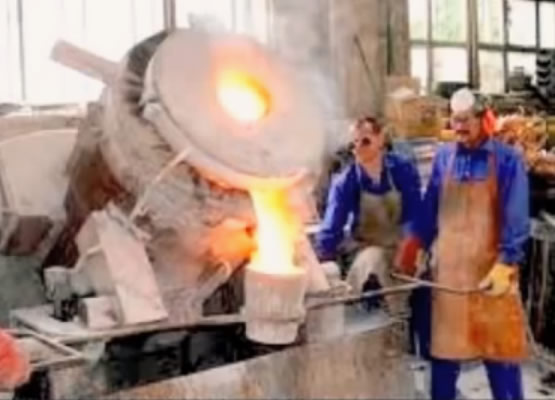The Process of Bronze Casting
The Artist Delesprie prides herself in having worked for decades casting Bronze Sculptures, Statuary, Life Size and Monumental Sculptures using the process of Bronze Casting. She has worked co-operatively with Land and Building Developers, Architects, Landscaping Architects, Builders, Contractors, City Planners, and City Council members.
Click the photo to watch the Process of Bronze Casting video.
Step 1
Once the sculpture is complete, it is then divided into sections. Depending on sculpture size specialized saws will be used, an artisan or jewelers saw for smaller pieces and a reciprocating saw for monuments. The head, torso, legs, arms, sometimes hands, and any forms not attached to the body, e.g. hair, any flowing garments and other accessories will all be cut off for mold making.
Step 2
A flexible rubber mold is made from the artist’s original clay. This modern material is able to capture every detail. For monument size sculptures the molds may take a couple of months. A mold is then prepared using layers of silicone rubber and fiberglass cloth. Next a plaster or fiberglass backing is added to provide support and structure to the mold. The original clay is then removed from the molds.
Step 3
Molten wax is then poured into the rubber mold, producing a casting of the original 3D. It is called a wax pattern.
Step 4
Once cooled the wax casting is removed from the mold, and hand-finished to perfectly match the original sculpture using dental tools and heat tools. The artist oversees and adds final details.
Step 5
An elaborate system of wax rods, called gates or sprues, are applied to the wax pattern or 3D wax.
Step 6
The investment shell casting process begins with the wax image being dipped into a mixture of silica sand and slurry (a highly complicated glue-like mixture called liquid colloidal silicone). This step takes several weeks to cure or harden into a rock like substance able to withstand the temperature of poured bronze, which ranges from 1800° to 2100° Fahrenheit. Extremely intricate parts, e.g. ½” fingers, are capable of being cast into bronze. The molten nature of the bronze, combined with modern-day molding materials, is able to detect details as fine as fingerprints.
Step 7
The ceramic mold is put into an autoclave (Kiln that produces extremely high temperatures), which bakes the ceramic and burns out the wax, leaving a hollow cavity in its place. Any remaining wax is steamed out to clean the mold of all wax remains. Thus the term, “Lost Wax Process.” Once the molds are d-waxed they are cooled and inspected for cracks.
The bronze ingots (bronze bars) are heated to liquid.
The ceramic mold is then filled with molten bronze (bronze is an alloy of 85% copper, 5% lead, 5% tin and 5% zinc). The price of bronze statues is based on all the labor and the price of mostly copper and all the sophisticated materials.
Step 8
After the bronze shell has cooled, the ceramic mold is carefully hammered and chiseled away, revealing the bronze sculpture within.
Step 9
Fine sand particles are blasted under air pressure to remove the last traces of ceramic shell that adhere to the bronze.
Step 10
The raw casting is then turned over to another artisan who cuts away the gates and sprues. The bronze parts are welded together like a large puzzle and then re-detailed using pneumatic tools (also known as air tools). The pieces are welded with great care and attention to the alignment. The artist may have to rework areas in the bronze. The sculpture is glass bead blasted which makes for an excellent surface finish in preparation for the patina.
Step 11
The chased (re-detailed) bronze is now treated with acid; using a blowtorch and an airbrush the bronze is heated and acid is sprayed on it to give it the chosen color according to the artist’s specifications and the client’s wishes. Varying the type of acid and how much heat is applied will create the different colors. We offer an extensive range of colors including: museum brown (aka French Bronze), light bronze, Verde green (aka Rodin green), burgundy, gold leaf and any color the commissioner requests. Two to three layers of protective coating are added to stop the process of oxidation and seal the emerged color. Large stainless steel pipes at least 2-3 feet in length are welded inside the monument and these same pipes extend out another 2-3 feet. These pipes will be placed into the cement for permanency. The monument is ready for installation. Or the final works are cautiously packaged and transported with care to our patrons. Throughout the process the artist oversees all steps to ensure quality and the adherence to the original.
Step 12
View videos of The Process of Bronze Casting.


